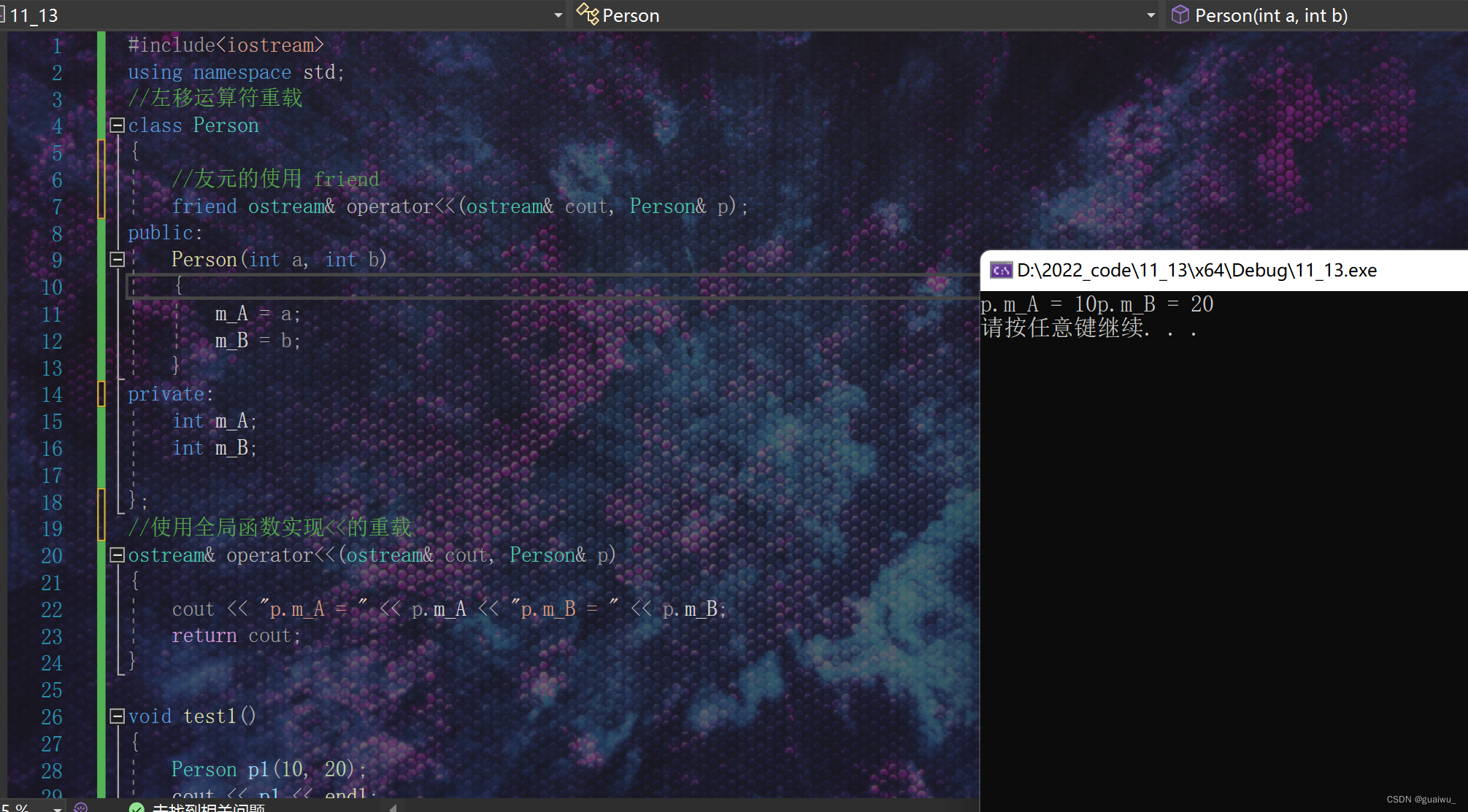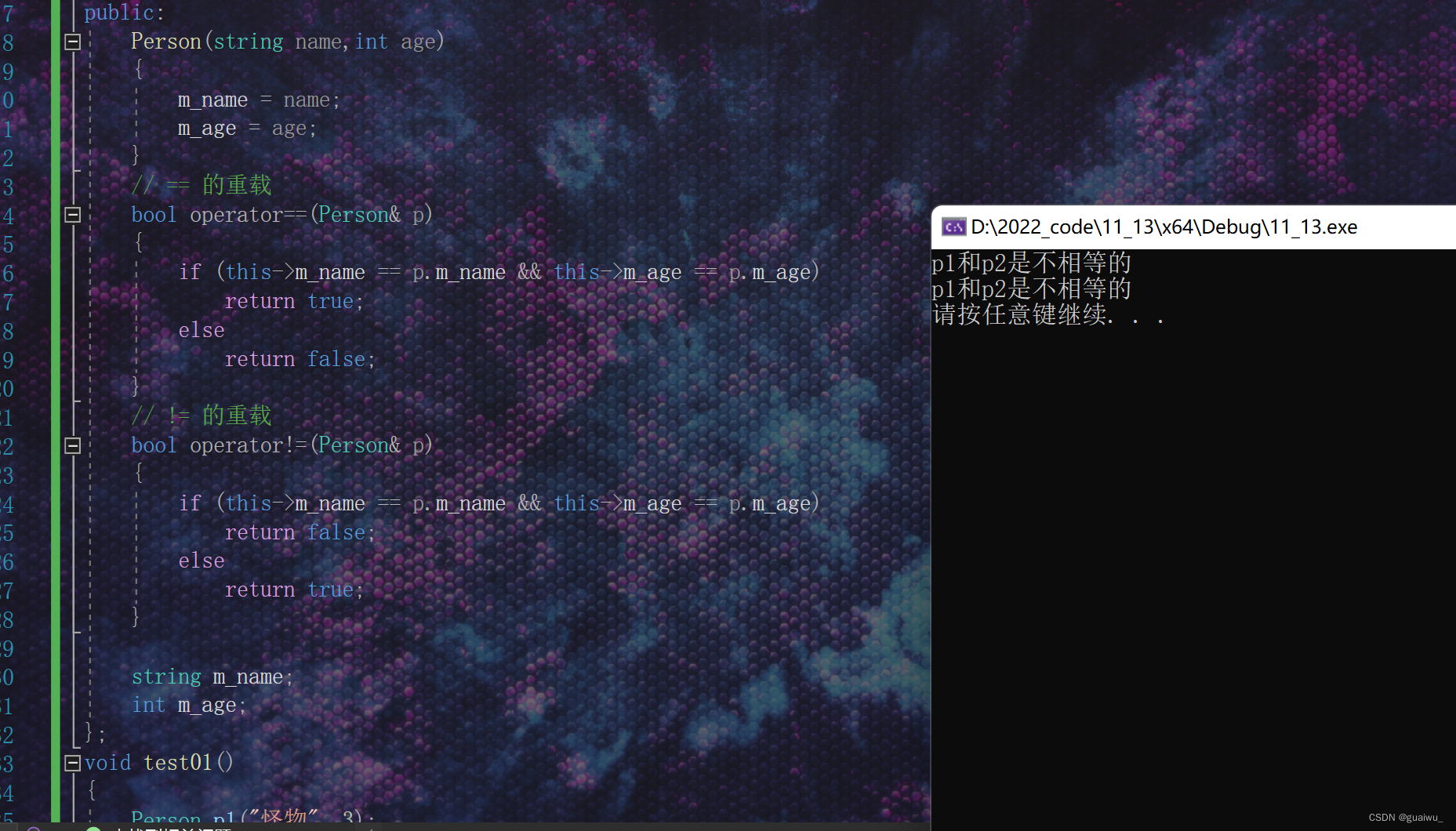目录
运算符重载的概念:对已有的运算符重新进行定义,赋予另一种功能,以适应不同的数据类型
作用:解决类中有属性在堆区,使用赋值操作时出现的深浅拷贝问题
运算符重载的概念:对已有的运算符重新进行定义,赋予另一种功能,以适应不同的数据类型
一、加号运算符重载+
作用:实现两个自定义数据类型相加的运算
(1)使用成员函数实现+号的重载
operator+是编译器给的通用名称,使用时可以帮忙简化
(2)使用全局函数实现+号的重载
(3)运算符重载也可以实现函数重载
二、 左移运算符重载<<
作用:可以输出自定义数据类型
#include<iostream> using namespace std; //左移运算符重载 class Person { //友元的使用 friend friend ostream& operator<<(ostream& cout, Person& p); public: Person(int a, int b) { m_A = a; m_B = b; } private: int m_A; int m_B; }; //使用全局函数实现<<的重载 ostream& operator<<(ostream& cout, Person& p) { cout << "p.m_A = " << p.m_A << "p.m_B = " << p.m_B; return cout; } void test1() { Person p1(10, 20); cout << p1 << endl; } int main() { test1(); system("pause"); return 0; }
解惑时间:
1.为什么没有使用成员函数的形式实现<<的重载?
因为在实现<<的重载时,cout 必须是左值,而在通过成员函数去实现<<的重载的时候,
cout只能出现在右值位置,所以无法实现
2.ostream是什么?
ostream是标准输出流,cout的类型就是标准输出流
3.为什么全局函数返回类型是ostream&?
返回ostream& 就是返回标准输出流的意思,这样在使用<<时就可以继续往后增加内容
三、递增运算符重载++
作用:通过重弄在递增运算符,实现增加的整形相加
#include<iostream> using namespace std; //++的重载 class MyInteger { friend void test1(); public: MyInteger() { m_A = 0; } //成员函数前置++的实现 MyInteger& operator++() { //先++ m_A++; //再返回 return *this; } //成员函数后置++的实现 MyInteger operator++(int) { //先存储 MyInteger num = *this; //然后++ m_A++; //最后再返回没增加前的对象 return num; } private: int m_A; }; void test1() { MyInteger p; p.m_A = 1; cout << ++(++p.m_A) << endl; cout << p.m_A++ << endl; cout << p.m_A << endl; } int main() { test1(); system("pause"); return 0; }
解惑时间:
(1)MyInteger operator++(int)之中的int是什么?
MyInteger operator++(int)之中的int是占位参数,是用来区分前置递增和后置递增的
递减运算符
四、 赋值运算符重载=
作用:解决类中有属性在堆区,使用赋值操作时出现的深浅拷贝问题
#include<iostream> using namespace std; class Person { friend void test1(); public: Person(int age) { m_age = new int(age); } ~Person() { if (m_age != NULL) { delete m_age; m_age = NULL; } } Person& operator=(Person &p) { //编译提供的浅拷贝 //m_age = p.m_age; //先判断是不是空指针 if (m_age != NULL) { delete m_age; m_age = NULL; } m_age = new int(*p.m_age); return *this; } private: int* m_age; }; void test1() { Person p1(18); Person p2(20); Person p3(30); p3 = p2 = p1; cout << "p1的年龄是:" << *p1.m_age << endl; cout << "p2的年龄是:" << *p2.m_age << endl; cout << "p3的年龄是:" << *p3.m_age << endl; } int main() { test1(); system("pause"); return 0; }
深拷贝与浅拷贝可以看一下这篇 http://t.csdn.cn/hUlsK
解惑时间:
(1)为什么成员函数的返回类型是Person&?
因为只有返回对象的别名才能进行连续赋值的操作
(2)return *this 是返回这个对象本身
五、关系运算符重载==/!=
作用:重载关系运算符,可以让两个自定义类型对象进行对比操作
#include<iostream> using namespace std; #include<string> class Person { public: Person(string name,int age) { m_name = name; m_age = age; } // == 的重载 bool operator==(Person& p) { if (this->m_name == p.m_name && this->m_age == p.m_age) return true; else return false; } // != 的重载 bool operator!=(Person& p) { if (this->m_name == p.m_name && this->m_age == p.m_age) return false; else return true; } string m_name; int m_age; }; void test01() { Person p1("怪物", 3); Person p2("怪", 3); if (p1 == p2) { cout << "p1和p2是相等的" << endl; } else { cout << "p1和p2是不相等的" << endl; } if (p1 != p2) { cout << "p1和p2是不相等的" << endl; } else { cout << "p1和p2是相等的" << endl; } } int main() { test01(); system("pause"); return 0; }
解惑时间:
好像没有什么难的点,就不解惑了
六、重载函数调用运算符()
由于使用方法类似于函数的调用,因此也被称为仿函数
匿名函数对象(使用后被立即回收)

































 232
232











 被折叠的 条评论
为什么被折叠?
被折叠的 条评论
为什么被折叠?








